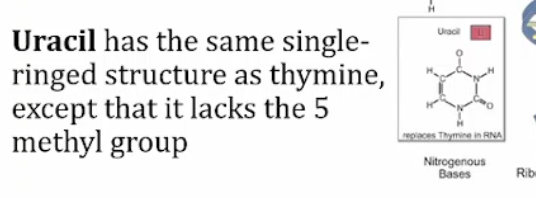Genetics -Nucleic acids
1/20
There's no tags or description
Looks like no tags are added yet.
Name | Mastery | Learn | Test | Matching | Spaced |
|---|
No study sessions yet.
21 Terms
What is the structure of a nucleoside
A nucleoside consists of a nitrogenous base bonded to a five-carbon sugar (ribose or deoxyribose), without any phosphate group attached.
What is the bond between the five carbon sugar and nitrogenous base in nucleosides called
B-Glycosidic bond
What is the bond between a phosphate group and ribose sugar called in nucleotides
Phosphodiester bond
What are the rules of base pairng
Adenine pairs with thymine(2 hyrdrogen bonds), Guanine pairs with cytosine (3 hydrogen bonds), each bond is 2 nmin distance between base pairs in the double helix structure.
What hydroxyl groups are the phosphodiester bonds formed at
the 3' (pyramidines) and 5' (purines) positions of the sugar
DNA backbone is always _____ and why
Hydrophillic. Polar phophate groups can interact with the polar enviroment
DNA helical structure is
right-handed and anti-parallel, allowing base pairs to stack and maximize stability.
DNA helix makes a complete turn every
3.4 nm
Stacked bases are packed ___ to base pairs per turn
0.34 nmper base pair.
How many base pairs per turn
10 base pairs per turn
Spaces between the helical structures are called by virtue of their width
Major groove and minor groove
Why are these grooves needed
Provide a place for proteins (transcription factors /DNA binding proteins ) to interact with DNA
What is the semi-conservative model of DNA
Each strand of DNA serves as a template to form a newcomplementary strand
What are the different forms of DNA
1) B form of DNA - naturally occuring
2) A form - appears when relative humidiy of enivroment is less than 75%
3) Z form - left handed double helix - difficult to observe as it is unstable
What are the unusual structures of DNA
1) Palindromic sequences - sequences that read the same forwards and backwards
2) Hairpin structures - formed when a single strand folds back on itself.
2) Mirror sequences - sequence where a DNA segment has a center of symmetry, meaning the sequence on one side of the center is the same as the sequence on the other side, but in reverse.
4)Inverted repeats - create intrabonds (between the same) - sequences where a DNA strand is followed by its reverse complement. These repeats, also known as palindromes, are common in both prokaryotic and eukaryotic genomes and can form secondary structures like stem-loops or hairpin loops
What is melting temperature of DNA
Temperature when half the bases in a double strand have denatured and formed a single strand. can be monitored at 260 nm.
What is hyperchromic effect
increase in UV absorbance that occurs when double-stranded DNA is denatured into single-stranded DNA. This phenomenon happens because the base pairs in double-stranded DNA stack together, limiting the absorption of UV light, while in single-stranded DNA, the bases are more exposed and can absorb more UV light, leading to a higher absorbance.
What is hypochromic effect
decrease in ultraviolet (UV) light absorption when DNA transitions from a single-stranded (ssDNA) to a double-stranded (dsDNA) state. This happens because the base-stacking interactions within the dsDNA structure reduce the absorption of UV light compared to the more freely absorbing ssDNA
What is the structure of RNA?
Has a ribose sugar -contains OH group at 2nd carbon
Has uracil instead of thymine
Is single stranded
What is the difference is between uracil and thymine
Uracil is a pyrimidine base found in RNA, while thymine is a pyrimidine base found in DNA. The key difference is that uracil contains a hydrogen atom instead of the methyl group present in thymine.
